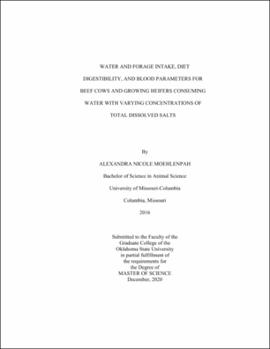| dc.contributor.advisor | Lalman, David | |
| dc.contributor.author | Moehlenpah, Alexandra Nicole | |
| dc.date.accessioned | 2021-05-25T20:42:24Z | |
| dc.date.available | 2021-05-25T20:42:24Z | |
| dc.date.issued | 2020-12 | |
| dc.identifier.uri | https://hdl.handle.net/11244/329968 | |
| dc.description.abstract | As water becomes a more limited resource, efficient water utilization is needed to continue animal production during water scarcity and declining water quality. The objective of this study was to investigate the effects of water quality on water intake (WI), forage intake, diet digestibility, and blood constituents in beef cows and growing beef heifers. The experimental design was two simultaneous 5 x 5 Latin squares with five drinking water treatments within each square: 1) control (fresh water-FRW); 2) brackish water (100 BRW treatment) with approximately 6,000 mg/kg TDS; 3) same TDS level as 100 BRW achieved by addition of NaCl to fresh water (100 SLW); 4) 50% brackish water and 50% fresh water to achieve approximately 3,000 mg/kg TDS (50 BRW); and 5) same TDS level as 50 BRW achieved by addition of NaCl to fresh water (50 SLW). Each of the five 21-d periods consisted of 14 d of adaptation and 5 d of data collection. Animals were housed individually, fed alfalfa cubes and provided one of the five water sources for ad libitum feed and WI. Feed and water intake were recorded daily, with recorded WI adjusted for vaporization. The PROC MIXED procedure of SAS 9.4 was used for data analysis where animal was the experimental unit. Age, treatment, and age x treatment were fixed effects, and animal ID within age was the random variable for intake, digestibility, and blood parameter data. Significance was declared at P ? 0.05, and a tendency was declared at P > 0.05 and P ? 0.10. Compared to previously published data, water and feed intake were extremely elevated regardless of age or water treatment. No treatment x age interactions were identified for WI (P = 0.71), WI expressed as g/kg body weight (BW; P = 0.70), or dry matter intake (DMI; P = 0.21). However, there was an age x treatment tendency for DMI when scaled to BW (P = 0.09) in cows consuming 100 BRW compared to fresh water. No differences were found for the other three treatments. Heifers consuming 50 SLW showed a significant difference (P < 0.05) for lower feed intake (g/kg BW) compared to fresh water and 100 BRW. No statistical differences (P > 0.05) in water, feed intake or diet digestibility were found due to water quality treatment. In conclusion, under these conditions neither absolute WI, absolute feed intake, nor diet digestibility were influenced by the natural brackish or saline water used in this experiment. These results suggest that further research is necessary to determine thresholds for TDS or salinity concentration resulting in reduced water and/or feed intake and diet digestibility. | |
| dc.format | application/pdf | |
| dc.language | en_US | |
| dc.rights | Copyright is held by the author who has granted the Oklahoma State University Library the non-exclusive right to share this material in its institutional repository. Contact Digital Library Services at lib-dls@okstate.edu or 405-744-9161 for the permission policy on the use, reproduction or distribution of this material. | |
| dc.title | Water and forage intake, diet digestibility, and blood parameters for beef cows and growing heifers consuming water with varying concentrations of total dissolved salts | |
| dc.contributor.committeeMember | Pezeshki, Adel | |
| dc.contributor.committeeMember | Goetsch, Art | |
| dc.contributor.committeeMember | Beck, Paul | |
| osu.filename | Moehlenpah_okstate_0664M_16990.pdf | |
| osu.accesstype | Open Access | |
| dc.type.genre | Thesis | |
| dc.type.material | Text | |
| dc.subject.keywords | beef cattle | |
| dc.subject.keywords | digestibility | |
| dc.subject.keywords | feed intake | |
| dc.subject.keywords | water quality | |
| thesis.degree.discipline | Animal Science | |
| thesis.degree.grantor | Oklahoma State University | |
